USGS Cambridge Study
Potential Reductions of Street Solids and Phosphorus in Urban Watersheds from Street Cleaning
The Charles River, which flows through eastern Massachusetts, was exceeding its Total Maximum Daily Load (TMDL) for Phosphorus (P) in its lower basin. Because of this, the City of Cambridge was expected to reduce its phosphorus contributions to the basin by more than 65%. A TMDL is a limit set by an environmental regulatory agency for a given pollutant that a body of water can receive while still meeting water quality standards.
Phosphorus is a nutrient found in fertilizers and produced by the decomposition of organic material such as vegetation, leaves and animal waste. High concentrations of phosphorus in water can lead to algal blooms. An algal bloom is a rapid increase or accumulation in the population of algae potentially giving water a bad taste and odor and can cause anoxic water conditions.
Streets are a non-point source of pollutants such as nutrients, metals, and organics. Street cleaning is used as a Best Management Practice (BMP) for preventing those contaminants from entering stormwater systems, which would otherwise contribute to pollutant loads in water bodies.
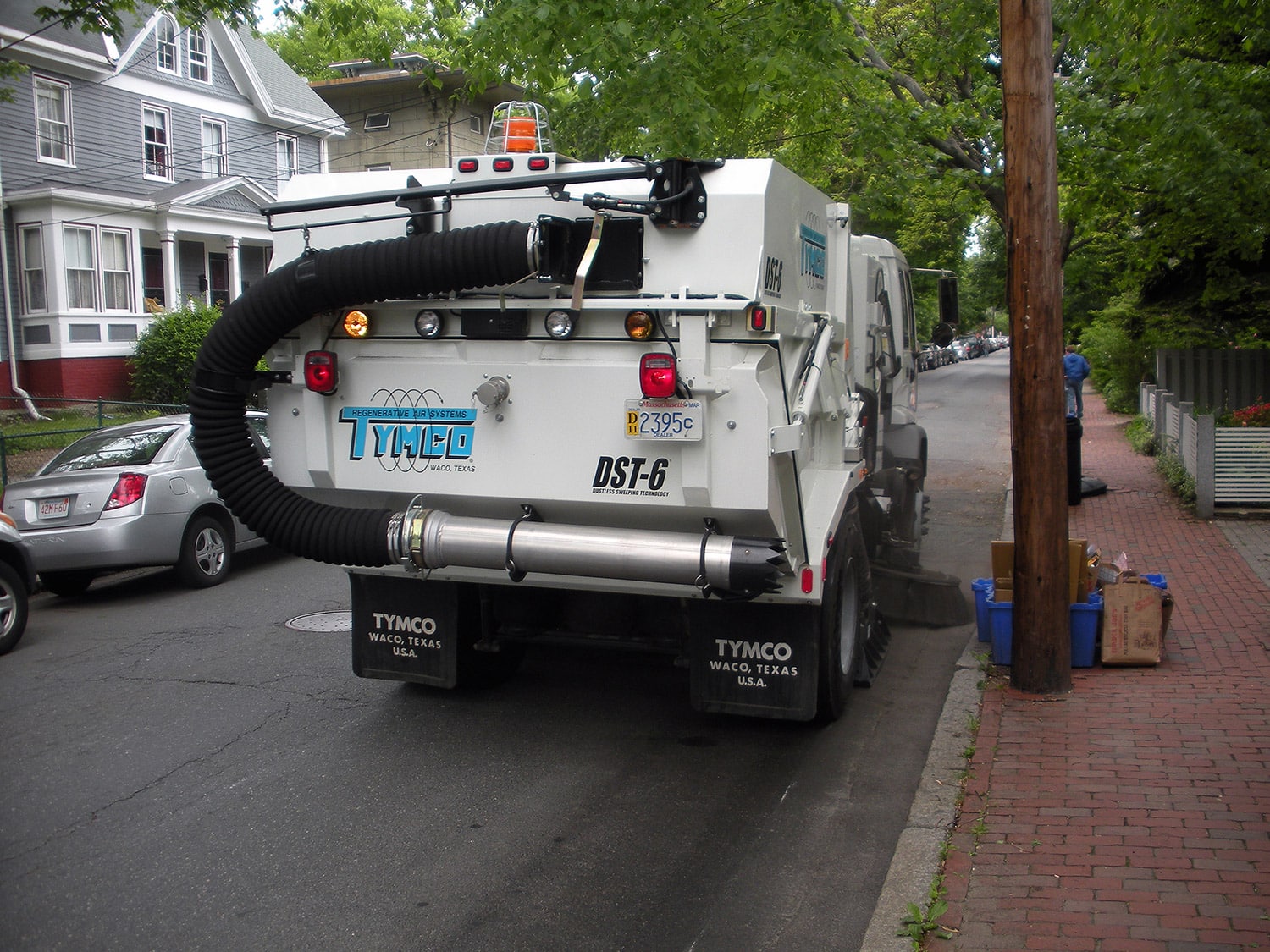
The U.S. Geological Survey (USGS), in cooperation with Massachusetts Department of Environmental Protection (MassDEP), U.S. Environmental Protection Agency (US EPA), the City of Cambridge, Massachusetts, TYMCO, and Casey & Dupuis Equipment embarked upon a study to:
- Objective 1 – Better understand the physical and chemical nature of the organic and inorganic solid material on street surfaces
- Objective 2 – Evaluate the performance of a TYMCO DST-6 regenerative-air street cleaner at removing street solids
- Objective 3 – Make use of the Source Loading and Management Model (SLAMM) to estimate potential reductions in solid and phosphorus loading to the lower Charles River with the use of various street-cleaning technologies and frequencies.
Objectives
Objective 1
In order to better understand the physical and chemical nature of the organic and inorganic solid material on street surfaces, 3 multifamily residential streets and 3 commercial streets were examined in this study.
Organic carbon and 32 other elements were characterized in the samples, including: Silver, Aluminum, Arsenic, Barium, Beryllium, Bismuth, Calcium, Cadmium, Cobalt, Chromium, Copper, Iron, Potassium, Lanthanum, Lithium, Magnesium, Manganese, Molybdenum, Sodium, Nickel, Phosphorus, Lead, Antimony, Scandium, Tin, Strontium, Titanium, Vanadium, Tungsten, Yttrium, Zinc, and Zirconium. Concentration, mass and particle sizes ranging from coarse (≥ 2 mm), medium (< 2 mm to ≥ 0.125 mm) to fine (< 0.125 mm) were also characterized.
The average yield was about 740 pounds per curb-mile on multifamily residential streets and about 522 pounds per curb-mile on commercial streets. The end of winter yields were much higher due to the fact that street cleaning was not conducted during the winter time with about 2,609 pounds per curb-mile on multifamily residential streets and about 4,788 pounds per curb-mile on commercial streets.
The washoff analysis showed an accumulation of about 33 pounds per curb-mile per day on multifamily residential streets and about 22 pounds per curb-mile per day on commercial streets. About 35% solids washoff occurred after rainstorms on multifamily residential streets and about 40% solids washoff on commercial streets. The accumulation of solids return to pre-rainstorm yields within 1-3 days. Percent washoff tended to increase with decreasing particle size. This is important because pollutants tend to bind more readily to smaller sized particles and regenerative air tends to do a better job of sweeping smaller sized particles than mechanical and vacuum machines.
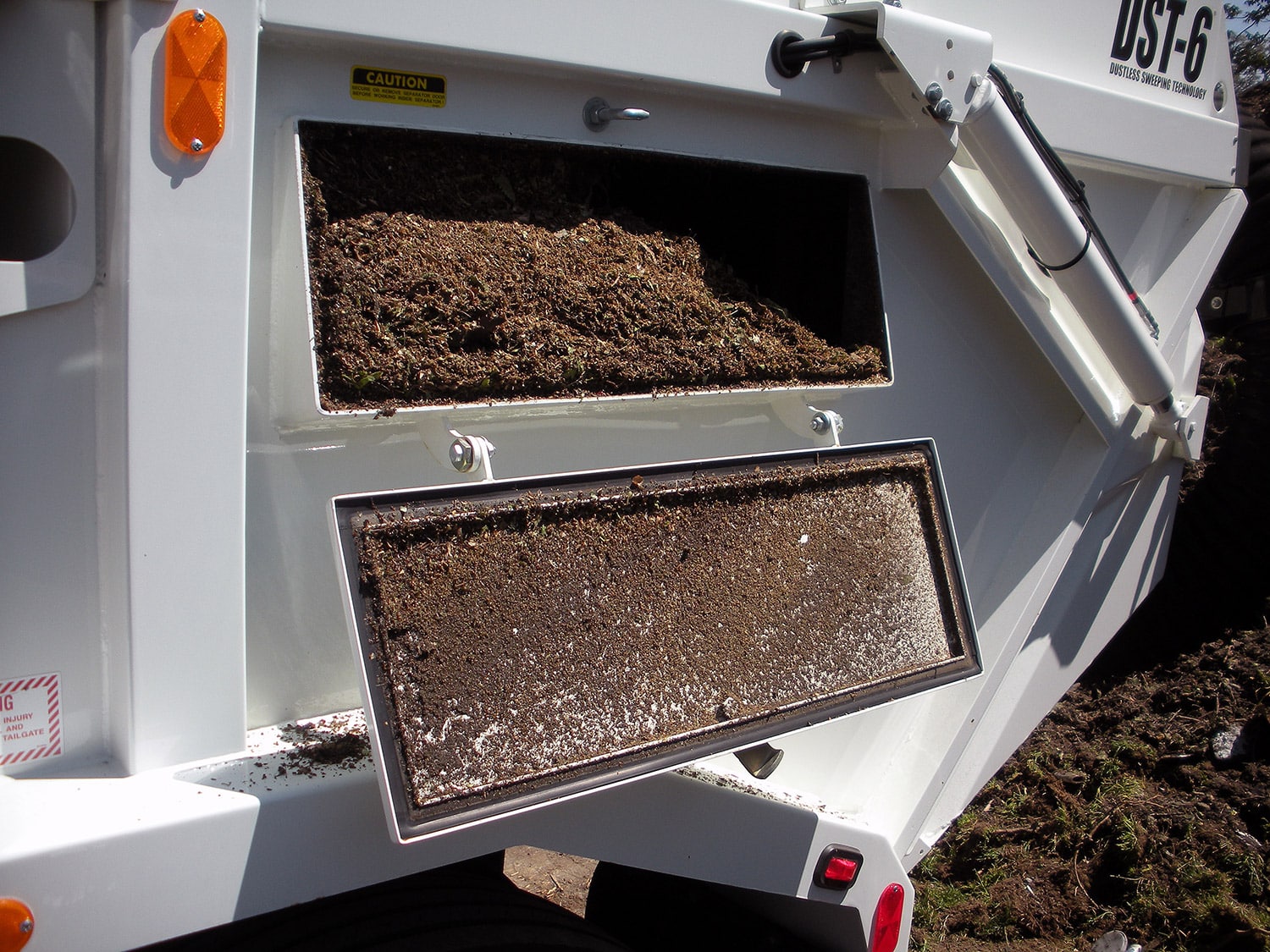
When observing solids distribution on the street, July composite samples showed 57% of solids within 3 feet of the curb, and 95% of solids were found within 9 feet of the curb. End of winter sampling showed 74% of solids were within 6 feet of the curb. This is notable, because earlier studies have shown as much as 90% of solids are found within 1 foot of the curb. Vacuum sweepers are designed with the suction nozzle on the right or left side of the sweeper, covering about 1/3 of the width of the sweeper, with the other 2/3 covered by a windrow broom, which can potentially leave material behind in the cracks and potholes in the street. Regenerative Air Sweepers have a pick-up head that covers the entire width of the sweeper, allowing for a deeper clean over a wider path.
Objective 2
In order to evaluate the performance of a TYMCO DST-6 regenerative-air street cleaner at removing street solids, samples were taken from the street with a stainless steel wet/dry vacuum, in a strip 9 feet wide from the curb toward the center of the street, before and after the pass of the regenerative-air street cleaner. Eighty-five total samples were taken over seven experiments from May to December 2010.
Median removal efficiency of solids was about 82% on multifamily residential streets, and about 78% on commercial streets. Median total phosphorus reductions were about 82% on multifamily residential streets, and about 62% on commercial streets. Reductions of other contaminants characterized in the street surface analysis were also accounted for.
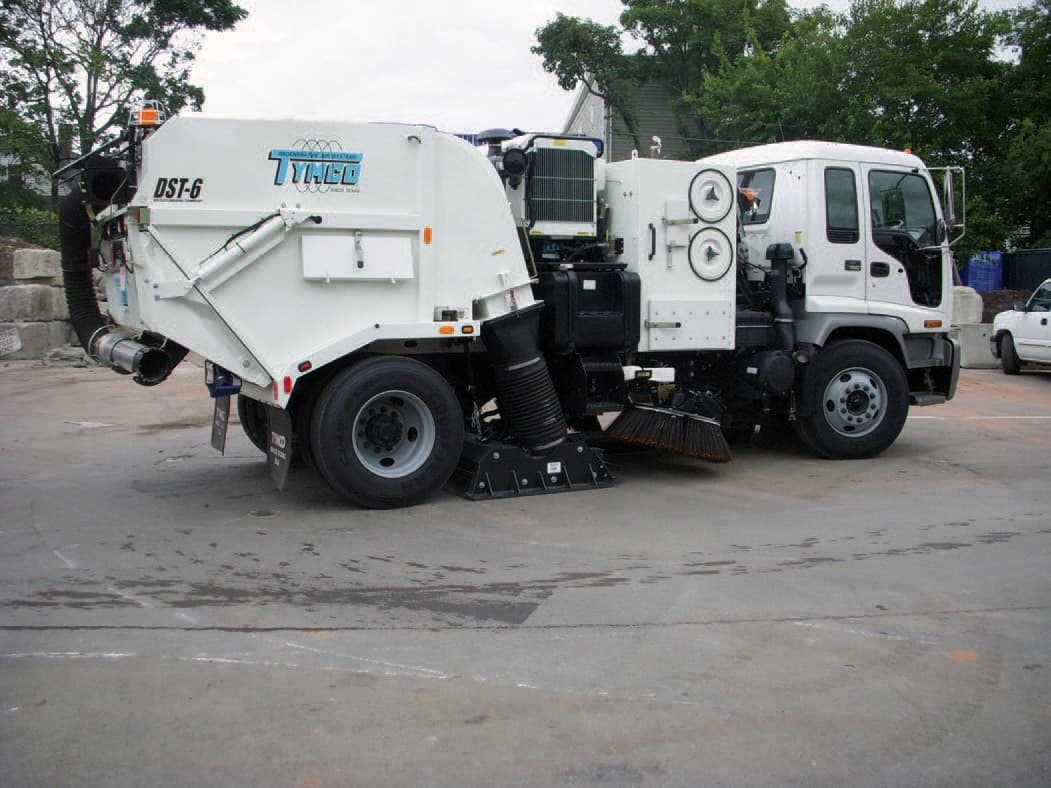
Objective 3
In order to make use of the Source Loading and Management Model (SLAMM) to estimate potential reductions in solids and phosphorus loading to the lower Charles River with the utilization of various street-cleaning technologies and frequencies; pick-up efficiency data that was collected from the second objective was entered into SLAMM and compared to pick-up efficiency data available on mechanical broom and vacuum sweepers from previous studies.
SLAMM is a computer simulation used to predict stormwater runoff volume, loads of suspended sediments and other constituents, and effects of stormwater control measures, such as street cleaning. Data is continually added for stormwater and control measure effectiveness. For this study, the model assumes 24-hour on-street parking controls and is based on 5 years of average climactic conditions.
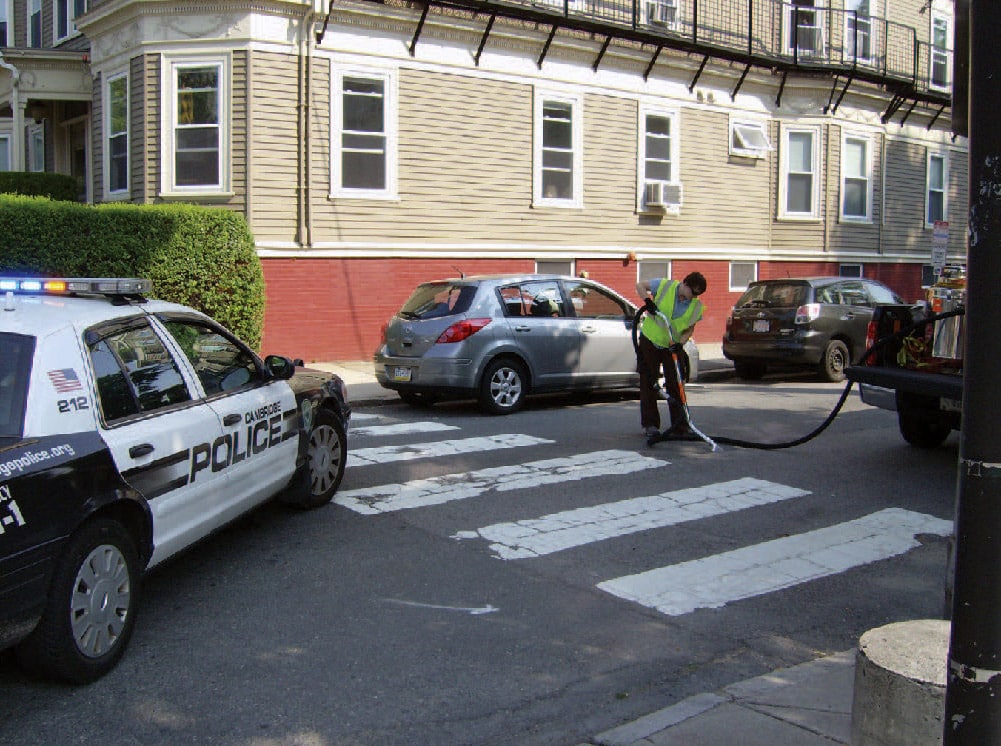
Total Percent Solids Reduction to Stormwater
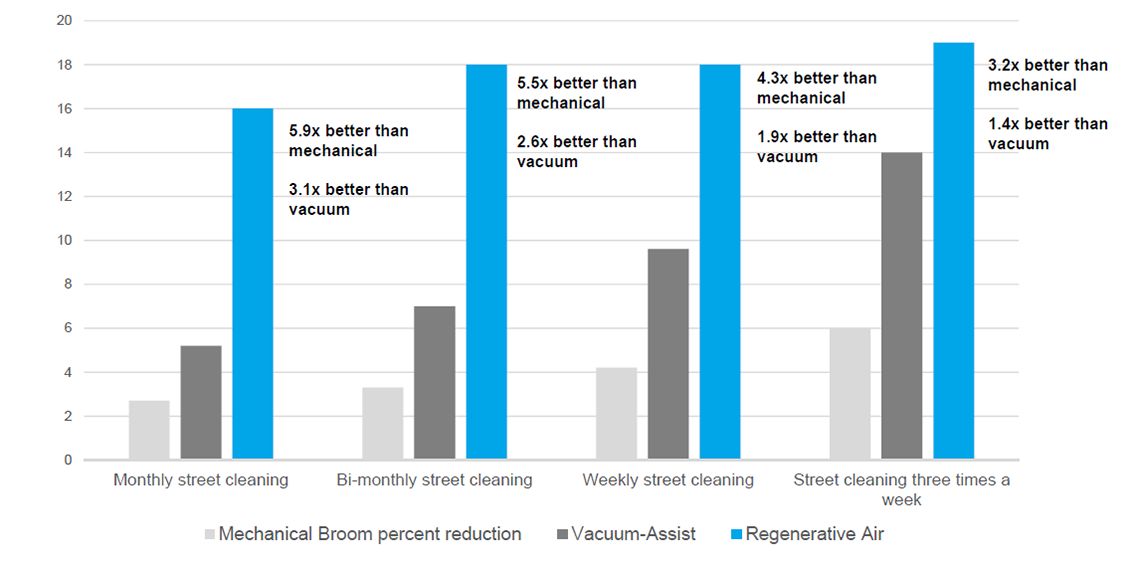
Sweeping with a regenerative air sweeper monthly is 2.7x more effective at reducing solids than sweeping with a mechanical sweeper three times a week and 1.1x more effective at reducing solids than sweeping with a vacuum-assist sweeper three times a week.
Total Percent Phosphorus Reduction to Stormwater
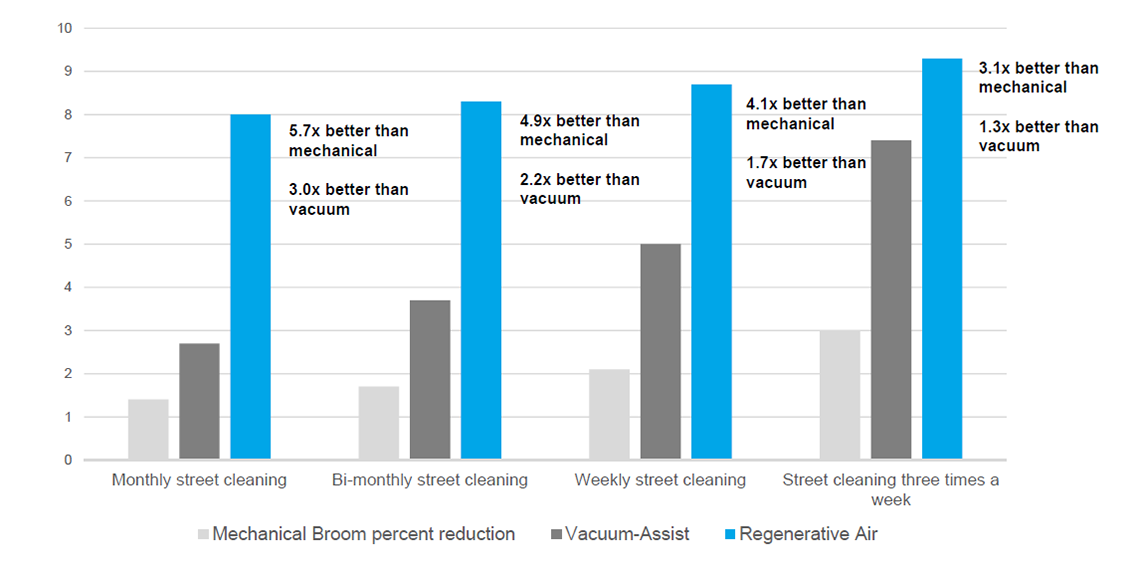
Sweeping with a regenerative air sweeper monthly is 2.7x more effective at reducing phosphorus than sweeping with a mechanical sweeper three times a week and 1.1x more effective at reducing phosphorus than sweeping with a vacuum-assist sweeper three times a week.
Solids and phosphorus reductions were estimated with street cleaning frequencies of monthly, bimonthly, weekly, and three times per week and were modeled using data for mechanical broom, vacuum, and regenerative air sweepers.
Interestingly, solids reductions when sweeping once per month with regenerative air were higher than sweeping three times per week when sweeping with mechanical or vacuum type sweepers. When sweeping once per month, regenerative air was 5.9 times more effective than mechanical, and 3.1 times more effective than vacuum type sweepers at reducing solids contributions to stormwater. When sweeping three times per week, regenerative air was 3.2 times more effective than mechanical, and 1.4 times more effective than vacuum type sweepers at reducing solids contributions to stormwater.
Percent reductions of phosphorus to stormwater were about half that of total solids, however performance results amongst sweeping technologies were similar. Phosphorus reductions when sweeping once per month with regenerative air were higher than sweeping three times per week when sweeping with mechanical or vacuum type sweepers.
When sweeping once per month, regenerative air was 5.7 times more effective than mechanical, and 3.0 times more effective than vacuum type sweepers at reducing phosphorus contributions to stormwater. When sweeping three times per week, regenerative air was 3.1 times more effective than mechanical, and 1.3 times more effective than vacuum type sweepers at reducing phosphorus contributions to stormwater.
Conclusion
- Streets represent a source of pollutants contributing to stormwater and air quality degradation, with organic carbon and 32 other elements being characterized.
- Full width street cleaning matters, with 57% of solids found within 3 feet of the curb and 95% of solids found within 9 feet of the curb.
- TYMCO DST-6 performance tests results for total solids pick-up efficiency were about 82% for multifamily residential streets and 78% on commercial streets.
- TYMCO DST-6 performance tests results for total phosphorus pick-up efficiency were about 82% on multifamily residential streets and about 62% on commercial streets.
- SLAM Model results show that when sweeping monthly, the regenerative-air street cleaner is 5.9x more effective than mechanical broom sweepers at reducing solids and 3.1x more effective than vacuum-assist sweepers at reducing solids.
- Sweeping once a month with the regenerative-air street cleaner is more effective at reducing solids and phosphorus contributions to stormwater than sweeping three times a week with mechanical or vacuum sweepers.
